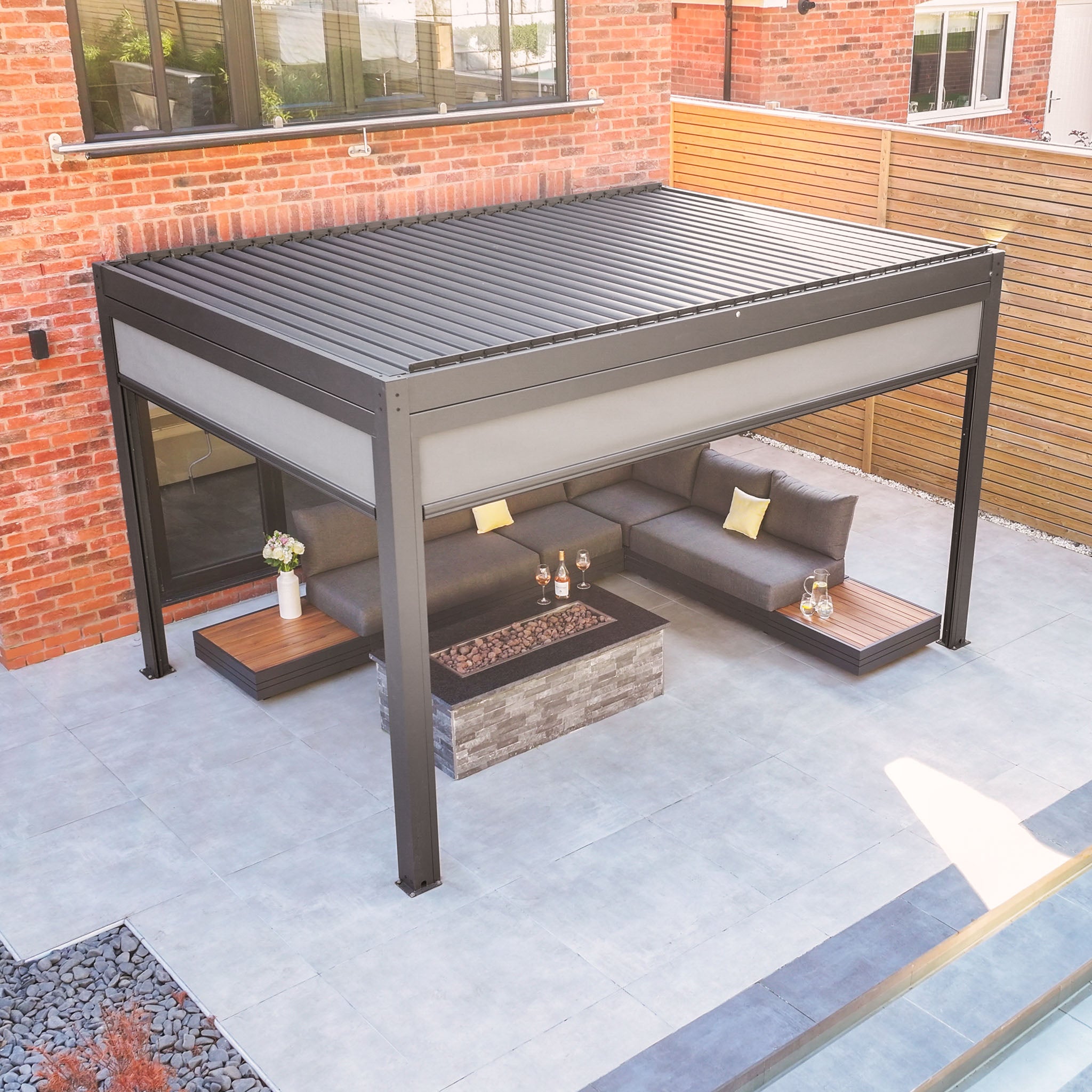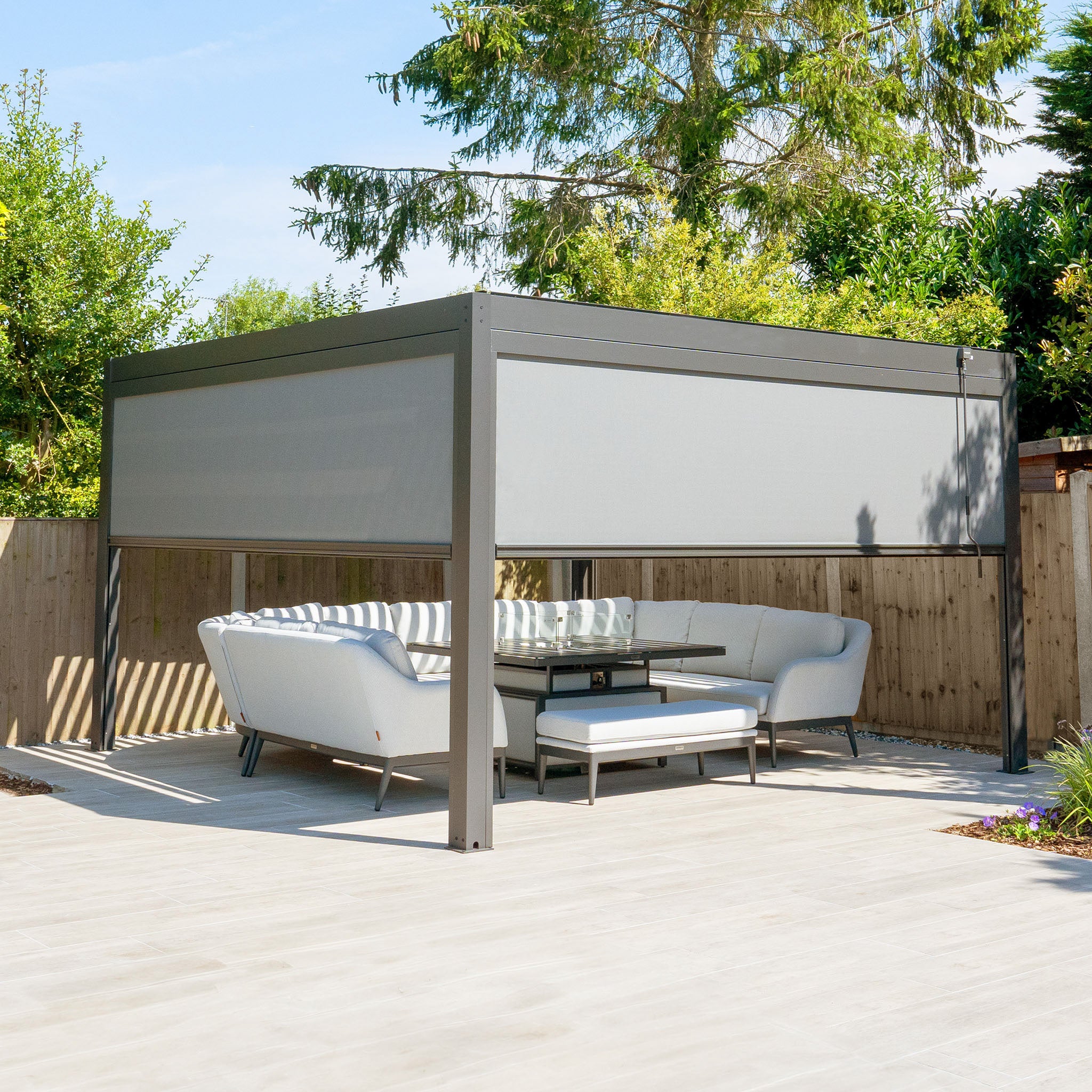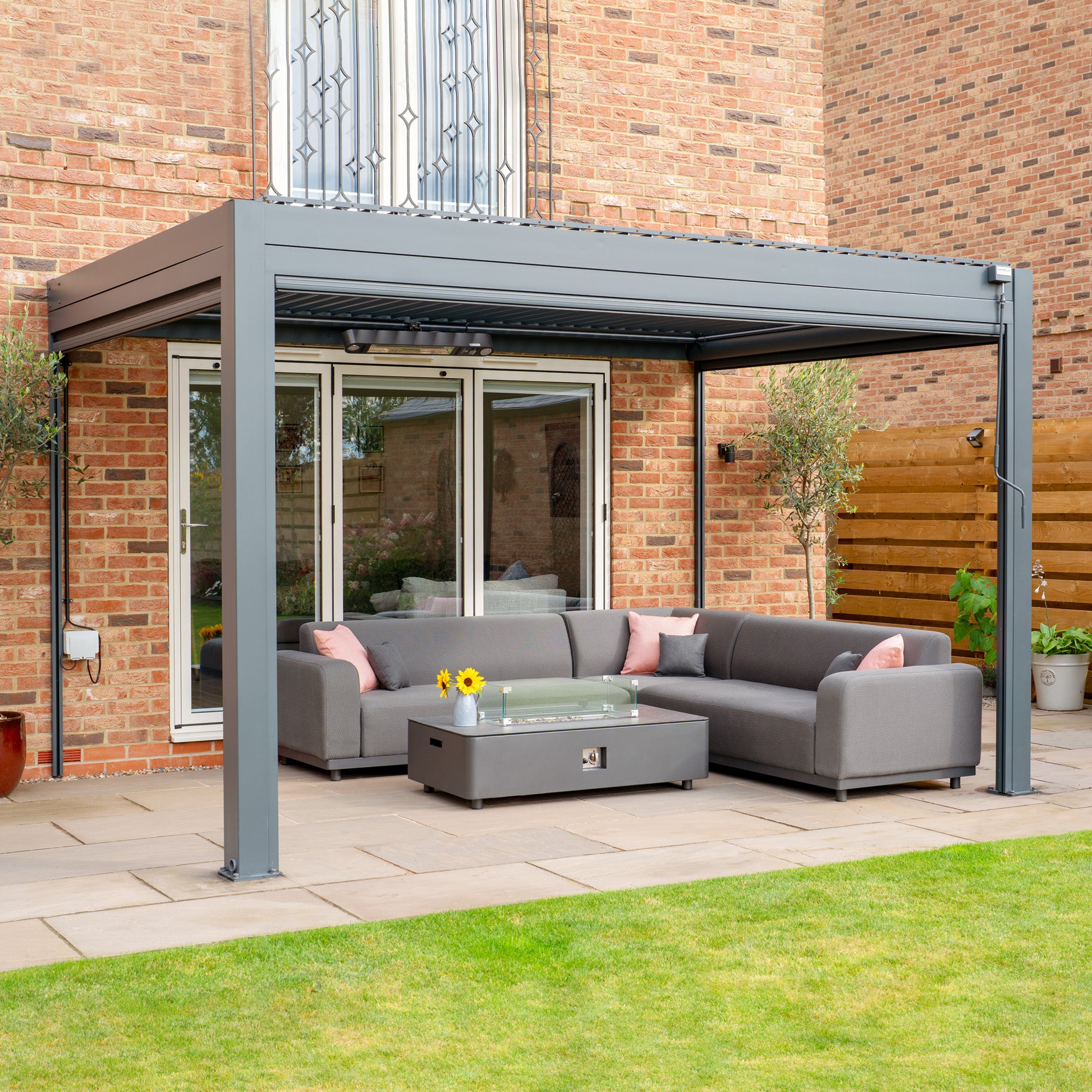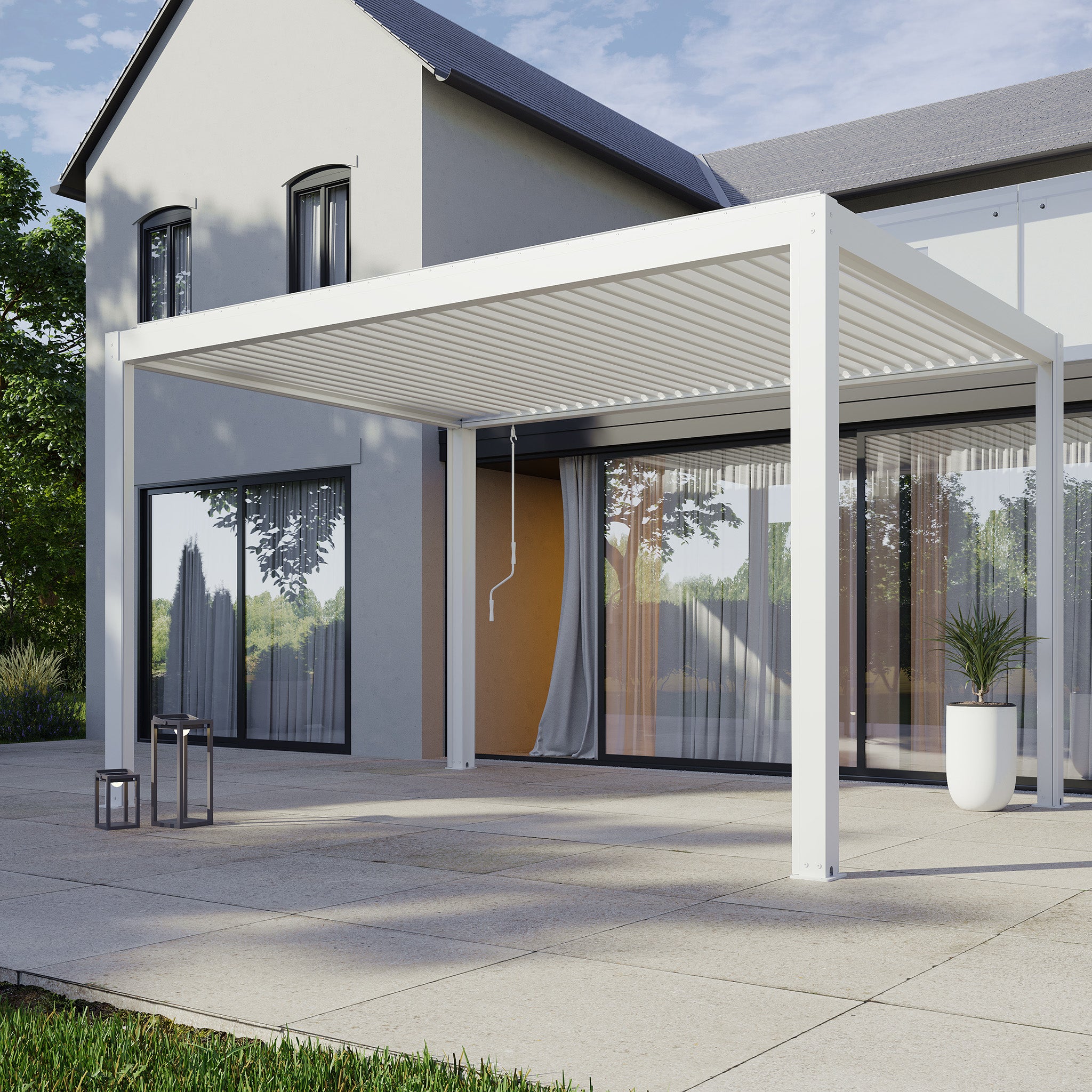

Pergola vs Gazebo: Which is best for your garden renovation?
Over the last couple of years investing in homes, renovations have increased in popularity. And there has been a massive shift toward taking advantage of our outdoor space.
However, sadly, we aren’t blessed with a Mediterranean climate in the UK, which means that we have to find a way to incorporate a shaded or sheltered area into our garden renovation plans.
Both gazebos and pergolas might offer a beautiful and practical solution, however, the terms are often used interchangeably, and many people aren’t clear on what the differences are. And despite their many similarities, there are a few differences that might make one more suitable than the other.
In this blog, we’re going to explore the differences (and similarities) between a gazebo and pergola to help you choose the one that is right for your garden.

WHAT IS THE DIFFERENCE BETWEEN A GAZEBO, PERGOLA AND A PAGODA?
First things first, let's get to grips with understanding the fundamental differences between a gazebo, pergola and pagoda. This will help you understand which one might be best for your garden renovation.
WHAT IS A GAZEBO?
A gazebo is a free-standing outdoor shade structure that is often octagonal or turret-shaped. They usually have a solid roof, with partially open sides to create a sheltered, shaded area.
Gazebo-like buildings have been around for thousands of years, with reports of them being used as far back as Ancient Egypt for purely practical purposes (such as shelter for winemaking).
Throughout the 19th and 20th centuries, it was common to see gazebos in town centres that would be used as bandstands. However, in recent years they’ve become far more popular in gardens and have both practical and decorative purposes such as:
Gazebos are best if you don’t have lots of shaded areas in your garden, and if you’d like to create a permanently sheltered area for use in all weather conditions.
WHAT IS A PERGOLA?
A pergola is similar to a gazebo in many ways, however, it’s usually a rectangular, outdoor structure that is made of columns and posts.
They traditionally have no permanent walls or sides and have a slatted or lattice style roof structure. This creates a shaded area, but also still allows light to shine through. They are most commonly “free-standing”, however, you can also get “wall-leaning” pergolas.
Traditionally, pergolas were built with weather-resistant wood, but maintenance-free materials such as vinyl, aluminium, stone or fibreglass have recently become more popular. They are beautiful and can create a decorative focal point in your garden, however, they also have many practical uses such as:

They are a really flexible solution for your garden, that offer both shelters and allow the light to stream through.
Related content: What is a pergola and should you buy one? A complete guide
WHAT IS A PAGODA?
A pagoda is another one that people use interchangeably with gazebo and pergola, so we thought we’d quickly outline what they are, and how their structure differs from that of a gazebo and pergola.
Pagodas originated in South Asia, and their shape is based on that of a Stupa (a tall mound-like structure used as a temple or place of worship).

They are now commonly used in gardens as a shade structure and have an upward tiered roof to keep sunshine or rain off the people under it. They often still incorporate the traditional elements of design and are especially popular in Zen or Japanese gardens in the UK.
Based on the above descriptions you might be thinking that gazebos and pergolas sound pretty similar. And in truth, they have many things in common, which is why the two terms are often used interchangeably.
However, despite their similarities, there are a few differences between the two that might make one more suitable for your garden than the other.
Let’s look into these in a little more detail…
GAZEBO VS PERGOLA: WHAT IS THE DIFFERENCE IN ROOF STRUCTURE
One of the primary differences between gazebos and pergolas is the function of the roof. A gazebo usually has a static roof that acts as a permanent shelter and provides full coverage from the sun (or the rain too).
It has a domed roof and is often built using a similar structure to that of the roof of a house. The style of the roof often mimics the house, so that it blends into it’s surrounding easily. This makes gazebos perfect for a permanent covered seating area, however, might be less enticing in the summer than a pergola.
On the other hand, a pergola often has a flat, slatted roof, which allows sunlight to shine through. This flat roof can make pergolas more attractive, as they can be more easily compliant with planning permission and permitted development rules.
In addition, the crisscrossed style of the typical wooden roof is an optimal environment for plants and vines to grow on and adds a decorative focal point to a garden.
However, some modern pergolas have a louvred roof, which has slanted horizontal slats that can be opened and closed with the control of a button. These slats can be rotated 180 degrees, which allows you to create a completely waterproof and shaded seating area.
A pergola with a louvred roof is a great compromise between a gazebo and pergola, as it offers shelter, which can be retracted or rotated when you want to let more light or air through.
It’s a very flexible seating option, which allows you to customise your outdoor space and is perfect for somewhere like the UK, where the weather can’t always be relied upon.
All our pergolas have louvred roofs, and built-in blinds to give you more control over how much shelter and shade is provided depending on the weather.
GAZEBO VS PERGOLA: WHAT IS THE DIFFERENCE IN WALL STRUCTURE?
Another common difference between gazebos and pergolas is their wall structure.
Gazebos can have sides that are completely open to the air, however, they often have a railing, half wall or can even be fully enclosed with large windows to take in the view. Again, this makes gazebos a great choice for people looking for a permanently sheltered area.
In comparison, pergolas usually have open walls, however, more modern iterations can have retractable blinds that can offer some more shelter from the elements.
All the pergolas that we sell have built-in blinds that are fully retractable and can be fully open or closed. This makes our pergolas a very flexible option as the shelter can be customised to suit the weather conditions.
GAZEBO VS PERGOLA: WHAT IS THE DIFFERENCE IN SHAPE?
It’s not always possible to tell the difference between a gazebo and a pergola just from the shape as they can be similar, although there are some tell-tale signs.
Gazebos usually have a round, hexagonal or octagonal shape, with a domed roof that is supported by 6 to 8 symmetrical pillared columns.
In contrast, pergolas are almost always rectangular, or square-shaped, built with columns and a lattice style roof.
It’s likely that you will have a personal preference on which shape of building you will prefer. However, you might be limited to one or the other depending on the size or shape of your garden.

GAZEBO VS PERGOLA: WHICH SHOULD YOU BUY?
So, now that you know the difference between the two, it’s time to figure out which one will suit your garden needs best.
PROS OF INSTALLING A GAZEBO...
- It’s a permanent structure and could add value to your home if built well.
- They help you utilise the outdoor space in your garden and create a space that is permanently sheltered from the elements.
- They are protected from the weather, so you can run electricity to them and enjoy lighting or music.
- They can be built from multiple different materials including wood, vinyl, aluminium and iron - so you can find one to suit the aesthetic of your garden.
- They create a beautiful, and functional spot in your garden.
CON OF INSTALLING A GAZEBO…
- Depending on the style, they can be more expensive to build as they have a solid roof and sides.
- They are permanently sheltered, which makes them less flexible and might feel more enclosed than a pergola.
- They can be less elegant looking than pergolas, and you’ll need to ensure it doesn’t take up too much space or it will look overwhelming.
- While they can be made of different materials, metal gazebos will become very hot in the summer, and wood gazebos will require regular maintenance.
PROS OF INSTALLING A PERGOLA…
- They are multi-functional and help you to take advantage of your outdoor space.
- Pergolas are relatively easy to construct and can be built with 2-3 people in just a few hours.
- They are very flexible and can be used as a shelter, while still allowing sunlight in.
- You can build them using a range of materials including wood, vinyl and aluminium - so you can usually find one to fit your style and budget.
- They will create a beautiful, and practical space outdoor space in your garden.
- Their design is very elegant and can look less cluttered than a gazebo especially if you have a small garden space.
CONS OF INSTALLING A PERGOLA…
- If you plan on growing plants on the lattice roof it might take a while, and require maintenance.
- Traditional lattice style roofs don’t offer much shade unless you have plants growing on them (however louvred roofs help to mitigate this disadvantage).
- If they don’t have any sides then there is little shelter from the elements, (however you can install retractable blinds to minimise this).
- Wooden pergolas will require ongoing maintenance and painting to ensure that they last a long time.
- They are most often rectangular, so don’t offer a lot of different design options.
READY TO INSTALL A PERGOLA?
Which building is best for you will be a completely personal choice, and will depend on the vision you have for your garden.
Gazebos can be a brilliant addition to your garden, offering a beautiful, and practical outdoor area with permanent protection from the elements.
However, with some of the modern iterations (ie. louvred roof, retractable blinds), pergolas offer a much more flexible option with many of the same benefits as gazebos and so can be a stronger option for many gardens. They can provide shelter from the UK weather, while still allowing you to enjoy the sunshine on our rare beautiful day - they really are the best of both worlds.
You can view our full range of pergolas here.
Related content: What is a pergola and should you buy one? A complete guide



















































































































